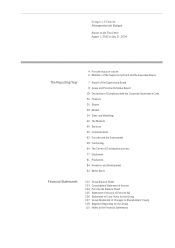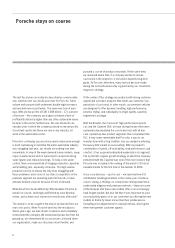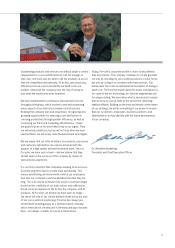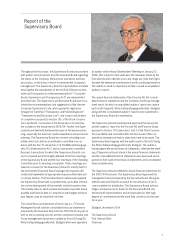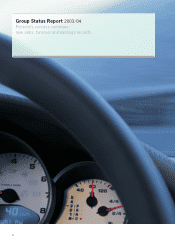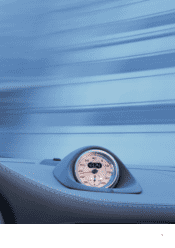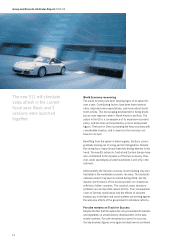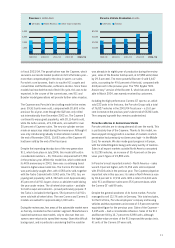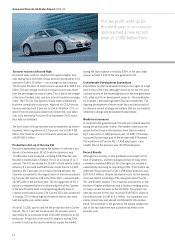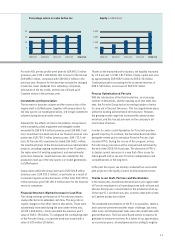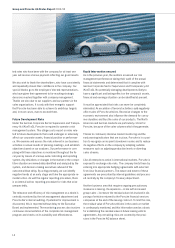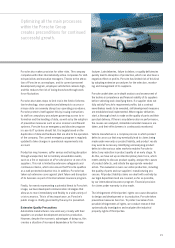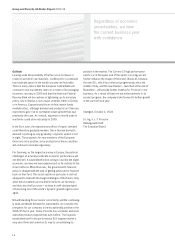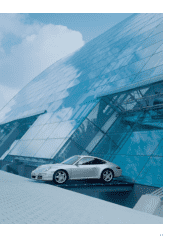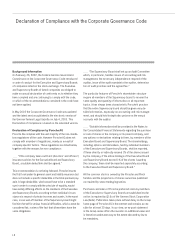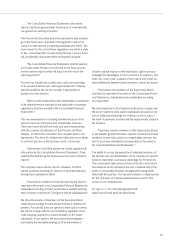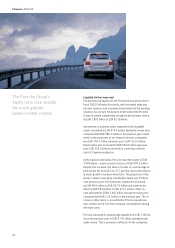Porsche 2003 Annual Report Download - page 16
Download and view the complete annual report
Please find page 16 of the 2003 Porsche annual report below. You can navigate through the pages in the report by either clicking on the pages listed below, or by using the keyword search tool below to find specific information within the annual report.
12
Turnover reaches a Record High
Increased sales volumes resulted once again in higher turn-
over during fiscal 2003/04. Group turnover increased by 13.9
percent to EUR 6.36 billion – a record high for the company.
The Porsche AG share of total turnover amounted to EUR 5.16
billion. The percentage increase in Group turnover was lower
than the percentage increase in sales. This is due to the change
in the mix of models sold, and also to less favorable exchange
rates. The CTS Car Top Systems Group made a substantial
first-time contribution to turnover. Adjusted for CTS, Porsche
turnover went up by 8.2 percent to EUR 6.04 billion. CTS, of
which Porsche previously owned only 50 percent, was taken
over in its entirety by Porsche AG in September 2003 and is
thus fully consolidated.
The lion’s share of Group turnover was accounted for by vehicle
business, which registered a 12.9 percent rise to EUR 4.88
billion. The financial services companies achieved a turnover
of EUR 556.0 million.
Production start-up of the new 911
Porsche substantially increased the number of vehicles it pro-
duced in the review year. 81,531 vehicles (previous year:
73,284 units) were produced, including 8,862 Boxster and
Boxster S models built in Finland. This is an increase of 11.3
percent. The 911 accounted for 26,650 of total vehicle output
(down by 9.9 percent) and the Boxster model line for 13,462
(down by 28.3 percent). As a result of strong demand, the
Cayenne accounted for the largest share of vehicles produced
by Porsche. We built 41,149 units of this SUV, compared with
24,925 units in the previous year. The strong growth of 65.1
percent is explained by the fact that production of the Cayenne
in the new Porsche plant in Leipzig had gradually been in-
creased in the previous year. The Carrera GT is also produced
in Leipzig; 270 of these high-performance sports cars were
built during the year under review.
A total of 31,250 sports cars left the production line in Zuffen-
hausen. The 3.1 percent increase over the previous year is
due mainly to an increased share of Boxster production in Zuf-
fenhausen. Production of the new 911 began in spring 2004
in order to build up the stocks needed to supply the market
during the launch phase in mid-July 2004. In the year under
review, we built 3,432 of the new generation 911.
Considerable Development Expenditure
Expenditure on internal development was once again at a high
level in fiscal 2003/04. Although resources for the 911 were
cut back in view of the impending launch of the new-generation
911, other sports car development projects – the new Boxster,
for example – demanded greater financial commitment. The
ongoing development of three model lines and the pursuit of
an intensive variant strategy are matters that are consistently
reflected in design and development expenditure.
Workforce increased
In contrast to the general trend, Porsche also created new jobs
during the period under review. The number of persons em-
ployed by the Group on the balance sheet date increased
by 9.1 percent to 11,668 (previous year: 10,699); CTS Group,
accounted for the major part of the increase with 939 people.
The workforce of Porsche AG – 7,992 employees – was
smaller than in the previous year (8,078 employees).
Record Results
Although the economy is only gradually recovering from its
bout of weakness, and the earnings position of many other
carmakers remained difficult, Porsche again succeeded in
substantially improving its operating profits. Profit before tax
within the Group went up to EUR 1.088 billion (previous year:
EUR 933.0 million), despite substantial costs for the develop-
ment and launch marketing of the new-generation Porsche
911 and Boxster models. This result was achieved by a com-
bination of higher productivity and a cautious hedging policy
on major currencies such as the US dollar. The group’s net
after-tax income for the year rose from EUR 565.0 million in
the previous year to EUR 612.0 million. Our subsidiary com-
panies in Germany and abroad contributed to this positive
trend. The slowdown in the growth of the annual surplus was
due to the fact that there was a positive tax effect in the
previous year.
Group and Porsche AG Status Report 2003 ⁄ 04
Pre-tax profit went up for
the tenth year in succession
and reached a new record
level of 1.088 billion Euro.



